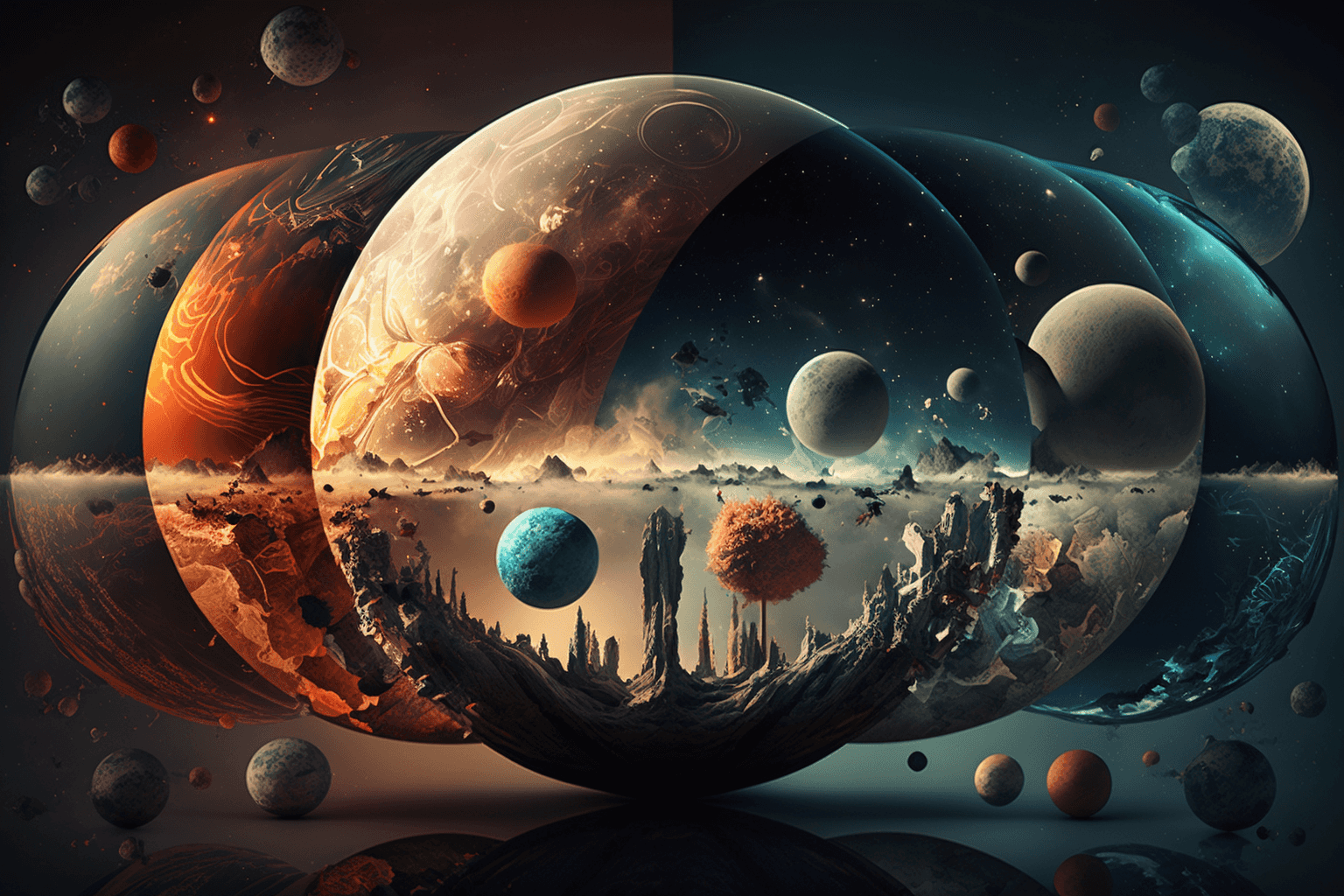My parents bought me a copy of Max Tegmark's book, "Our Mathematical Universe", nearly a decade ago. It explores the story modern physics tells us about the possibility of a multiverse.
To this day, it's one of my very favourite books.
What's so compelling about multiverse theories is that at least some of them are logically entailed by mainstream theories of physics. We'll look at some extraordinarily weird, wonderful yet scientifically serious predictions of modern physics, and their jaw-dropping implications.
What is the "multiverse?" anyway?
The "multiverse" is a really broad term.
Loosely, it refers to the possibility of collections of multiple universes.
As we'll discover, though, there are numerous types of multiverse being discussed, multiple of which could be true at the same time.
The four levels of the multiverse
In Our Mathematical Universe, he suggests four distinct levels of the multiverse, each stemming from a different area of physics and cosmology.
Each is immense beyond words, and fascinating in its own right.
Three of these correspond to distinct scientific areas of enquiry. So I'm going to conduct our tour through the multiverse using Max Tegmark's insights to structure our exploration.
Along the way, I'll try to explain how some major modern theories of physics fit into each one, and what each multiverse prediction might entail.
I'm not a physicist – just a nerdy philosophy grad who loves cosmology – but I'll point out some further reading at the end and along the way.
Level I: The Quilted Multiverse
To explain what the Level I multiverse is, I'll start with what a Hubble volume is. A Hubble volume is a volume of space with a radius around 14 billion light-years across – a volume representing everything currently visible from Earth, the boundaries of our "local" visible universe.
So, the idea of the Level I multiverse is that if space is infinite, then there must be an infinite number of Hubble volumes.
In Tegmark's words, Level I multiverses are:
"Distant regions of space that are currently but not forever unobservable; they have the same effective laws of physics but may have different histories"
Parallel universes aren't in themselves a theory. Rather, they're a prediction of other theories. The Level I multiverse is a prediction of inflation. You can't have inflation without the Level I multiverse. Tegmark explains:
"An important thing about physics theories is that if you like one, you have to buy the whole package... You can't buy general relativity with the black holes removed... In the same way, parallel universes aren't optional in eternal inflation."
I don't want to get too mind-bending too early, but an implication of a Level I universe is that you aren't the only copy of yourself.
An infinite Level 1 multiverse entails an infinite number of "you" doppelgängers – not to mention anyone or anything else that could possibly exist.
If it's metaphysically possible for something to exist, it exists.
That follows from two assumptions, both of which are generally accepted within the scientific community. The first is that there's infinite space and matter. The second is that there were random seeds of matter early on. It's supported by observations such as the cosmic microwave background radiation. This radiation is the afterglow of the Big Bang and provides a snapshot of the universe when it was only 380,000 years old. The patterns in this radiation, such as its isotropy and temperature fluctuations, are consistent with the predictions of inflation and provide strong support for the theory.
I can't finish this section without at least nodding to what to me feels like an elephant in the room. How could an infinite space fit inside a finite volume, or be created in a finite time? Well, I'd love to try and answer that, but it's a huge question with a huge answer. The long and short of it is that, through the magic of mathematics, an infinite volume can fit inside a finite volume. A lot of the magic happens inside the theory of general relativity, which, in very broad strokes, shows that because spacetime can bend in surprising ways, its geometry allows for infinite possibilities within finite regions. Fractals are a good way of thinking about this – infinite structures can exist within finite boundaries.
Level II: The Inflationary Multiverse
Eternal inflation predicts more than just the Level I multiverse. It predicts the Level II multiverse, too.
Unlike the Level I multiverse, it's impossible even in principle to jump between Level II areas of spacetime, because inflation is creating intervening space faster than you can travel.
So what are Level II multiverse regions? Tegmark describes them as:
"Distant regions of space that are forever unobservable because space between here and there keeps inflating; they obey the same fundamental laws of physics, but their effective laws of physics may differ"
In the Level I multiverse, all of the possible Hubble volumes obeyed the same laws of physics – our laws. What's cool is that in the Level II multiverse, the effective laws of physics might differ, though we need to look a bit deeper to flesh out what that means.
Tegmark explains:
"If you were a fish who'd lived your entire life in the ocean, you might make the mistake of thinkng of water not as a substance, but as empty space... You'd probably have no idea that water can exist in three different phases – solid, liquid and gaseous – and that your "empty space" was simply the liquid phase, a particular solution to the equations describing water"

Just floating in empty space? Credit: Author, Midjourney
There's now mounting evidence that our empty space, following this example, also has other phases.
And far more than the three water has. Modern theories predict 1 × 10^500 possible phases – maybe more.
Physicists are searching for the equations that describe our space and its possible phases, and right now, the hot contender is string theory. I'm not going to get into this. I've thought about writing about string theory before, but it's so complex, I'd not be able to do a good job of it. What I understand is roughly this: the universe is made up of tiny loops which vibrate at different frequencies. Their frequency defines what type of particle type or force they are. Different regions of the Level II multiverse might have strings which behave in different ways, giving rise to the different phases I described earlier.
Why's all this important?
Well, it's because eternal inflation necessarily entails all possible kinds of space. Maybe all 1 × 10^500 of them. Back in the early days, when the universe was full of energy, there was enough energy – more than enough – to change the phase of space. Each region would inflate to become an enormous region, but become separated by inflating boundary regions.
Level III: The Many Worlds Interpretation of Quantum Mechanics
The Level III multiverse is rooted in the Many Worlds Interpretation (MWI) of quantum mechanics.
According to this theory, every time a quantum event occurs, the universe splits into multiple branches. Each branch contains one of the possible outcomes of the quantum event.
This leads to an immense number of parallel universes, each representing a distinct sequence of events and choices.
The thought experiment of Schrodinger's cat illustrates the weirdness of quantum mechanics. I remember my dad explaining it to me when I was 13 years old, sat in the car on the winding country roads on the way home from school. A hypothetical cat in a sealed box with a radioactive source that has a 50% chance of decaying and releasing poison that kills the cat.
My dad explained that in quantum mechanics, it's broadly accepted that the act of observing an event can change the event itself. The act of observing the cat when you open the box causes the wave function to collapse, and you find out if the cat is alive or dead. Before you observe it, the cat is in a state of being both dead and alive.

Dead or alive? Or both? Credit: Author, Midjourney
I hated that.
It's as though humans create reality simply by looking at it.
Not to mention that it would mean randomness is fundamentally built into reality. "I cannot believe that God plays dice", once quipped Einstein.
I had such a strong feeling that something was wrong about this – in fact, this was the conversation that led me to study Philosophy at university. This feeling came from my early, undeveloped reductionist intuitions about matters like the philosophy of mind and metaphysics (I've since dedicated energy to defending reductionist accounts in places like here and here).
The MWI has a rather different account.
According to the MWI, when the source decays, the universe splits into two branches, one in which the cat is alive and one in which the cat is dead. When you observe the cat, you don't affect the cat's state. You just find out which universe you are in.
Is that easier to stomach?
Tegmark tells a story about a time he spoke with a famous quantum gravity theoriest, Bryce DeWitt. DeWitt explained he had once spoken with Hugh Everett, the scientist who came up with the MWI, and told Everett he just didn't feel like he was constantly splitting into multiple versions of himself.
"Do you feel like you're orbiting the Sun at 30 kilometres per second?" asked Everett.
"Touché!", replied DeWitt.
Level IV: The Mathematical Universe Hypothesis (MUH)
Our reality isn't just described by mathematics – it is mathematics.
Well, that's certainly parsimonious. If true, it explains the uncanny predictive power of maths to explain reality.
Earlier, we saw that the Level I and II multiverses are implied by inflation.
The Level IV multiverse is a non-negotiable outcome of something Tegmark calls the Mathematical Universe Hypothesis (MUH), which is this view that reality is a mathematical structure.
The Level IV multiverse is a vast, infinite set of every possible (mathematically consistent) mathematical structure.
That would mean worlds can have completely unrecognisable physical laws compared to our own.
Most mathematical structures – take a dodecahedron – can't sustain self-aware substructures (like humans). So the (infinite) set of multiverses is mostly a desert devoid of life, which is confined to a tiny subset of inhabitable "Goldilocks" multiverses. This also goes for our Level II multiverse, where life is only possible in a tiny percentage of multiverses where the effective laws of physics allow for the conditions of life. A tiny tweak in, say, the strength of the gravitational constant or the mass of the electron, would make life impossible.
Arguing about the multiverse
This is really important: parallel worlds are not theories. They are predictions of theories.
Interestingly, the vast majority of writers on the multiverse, which include Max Tegmark alongside other prolific physicists such as Brian Greene and Michio Kaku, do not explicitly assert that the multiverse exist. Rather, they explain the conditions required for the multiverse to exist.
In philosophy, we call this modus ponens: if X implies Y, and X is true, then Y must also be true. For us, "X" is the theory which predicts the multiverse, such as inflation or the Mathematical Universe Hypothesis.
That means there are only two ways to argue against them*****:
- Argue that X does not imply Y
- X is not true
As an example, to avoid the conclusion that the Level I multiverse exists, we have to do one of these two things:
- Argue inflation doesn't entail the Level I multiverse
- Argue against inflation
It turns out to be difficult, though not impossible, to do either without rejecting standard assumptions in physics. Arguing this way, though, helps us avoid facile appeals to the multiverse seeming "nonsense" or "absurd".
*Or, you could argue either against the method of scientific enquiry, or if you really wanted to, you could argue against classical logic, which is left-field but really interesting – I wrote a blog about that!)
FWIW...
I'm not a physicist, nor a mathematician, so I wouldn't presume to assign any truth value to any of the scientific matters. What I will say is that we should be willing to accept the logical consequences of our commitments in physics. I've never been keen on what has elsewhere been called "incredulous stare" quasi-arguments against prima facie unintuitive concepts, and have argued against them.
At the same time, I have two thoughts about the argument against parallel worlds from parsimony – in simple terms, that's the idea we should prefer simpler explanations with less baggage ("ontologically light") when all else is equal.
The first is that, by a simple interpretation of Occam's razor (I wrote about this here), the multiverse is disgracefully heavy – heavy beyond words – with physical baggage ("ontologically heavy"). Most of us will have an innate distate for how unintuitive it feels.
But the second thought is that, in some senses, it is actually more parsimonious, because it requires less logical explanation.
Rather than having to explain why we, here on Earth, are so special and how everything is so fine-tuned to our existence; or why the mere act of observing a quantum event makes the wave function collapse.
We simply say that we're not special at all – our existence is a logical inevitability. We say the wave function never collapses – observation has nothing to do with it.
Perhaps, on reflection, it's the logical parsimony we should value, rather than the non-proliferation of physical matter.
Further Reading
Our Mathematical Universe: My Quest for the Ultimate Nature of Reality – Max Tegmark – Possibly my favourite book ever written. Seriously! A lively, lucid journey through astonishing subject matter. Available from Hive
Just Six Numbers – Martin Rees – Explores how our existence wouldn't have been possible had six numbers that describe the nature of our universe. Interesting context with the "fine-tuning" argument in mind. Chapter 7 is about inflation. Available from Hive



